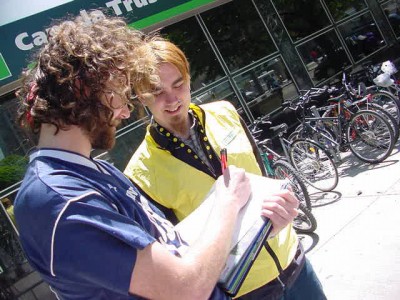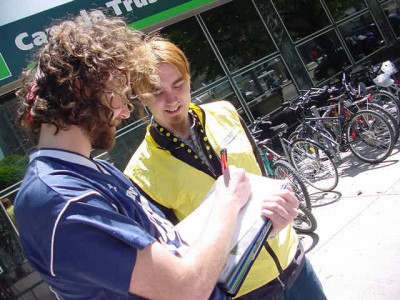 It’s officially summer, and one thing that brings, besides Kennedy yacht races on Nantucket Sound, is an army of thousands of kids with clipboards, out canvassing neighborhoods, street corners, and subway stops for green: green causes and the green of cash.
It’s officially summer, and one thing that brings, besides Kennedy yacht races on Nantucket Sound, is an army of thousands of kids with clipboards, out canvassing neighborhoods, street corners, and subway stops for green: green causes and the green of cash.
This tried and tested organizing tactic is a mainstay of many groups from Sierra Club to the PIRGs (college-based public interest research groups), and is one of the biggest, most regular shows of force that the green movement has outside of climate rallies and mountaintop removal protests.
It’s proven to build member rolls and donor bases, yet has many detractors. A guest commentator here at Grist started a heated debate 2 years back with his assertion that it’s a waste of effort, in that the clipboard horde does not invite or engender activism amongst those canvassed, and just turns people off when it asks for money. Better to just talk with people, or do outreach via electronic channels, he said.
Rereading the comments, I found much to agree with, both pro and con. Yes, some canvasses are worse than others in terms of info and action items. Much of the money raised goes to pay for the canvass effort, leaving little extra to fill out the group’s budget. Yes, it’s a really tough job that has a high rate of burnout. And yes, around 40 percent of what you give to the canvasser stays with him or her, not the group or mission.
But what the writer missed is that a canvass is often a group’s biggest outreach effort. It brings real people to others’ doors to start a conversation, no matter if these chats are sometimes clumsy, ill-informed, or frustrating. And it’s paid for by its own proceeds.
The canvasses I’ve worked, a PIRG fighting an incinerator in New York and a wolf reintroduction project in Colorado, were grueling but exhilarating. Both focused on gathering signatures and letters while distributing literature, and in the former case resulted in an outright win.
All we had to do was prove that recycling would handle just as much of the waste stream as burning trash would, at a fraction of the cost. But we had to do that one person at a time.
What I think is an under-appreciated aspect of canvasses, though, is that for many, it’s the first time they’ll get paid for their activism. And that’s crucial. If we want more green leaders tomorrow, we need to find them work today. Just look at the conservative movement to understand how important that is.
I didn’t stick with canvassing long, but used it as a stepping stone to other jobs in organizing, as so many do. It was a formative experience for me, to face my fear at every door and try to make a connection with a person who usually didn’t want to talk, and share my passion for this world. And along with other gigs I stitched together, I was making a living as an activist.
This is why I don’t flinch at giving a donation to someone at my door, after asking how else I can be involved. I know lots of people insist on sending their donations in by mail to the main office to avoid giving canvassers a cut, but not me. That 40% is part of what keeps green boots on the ground.



